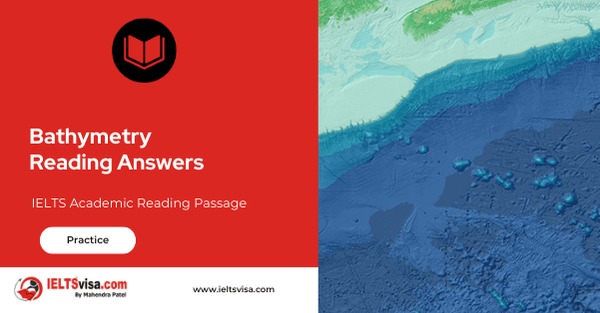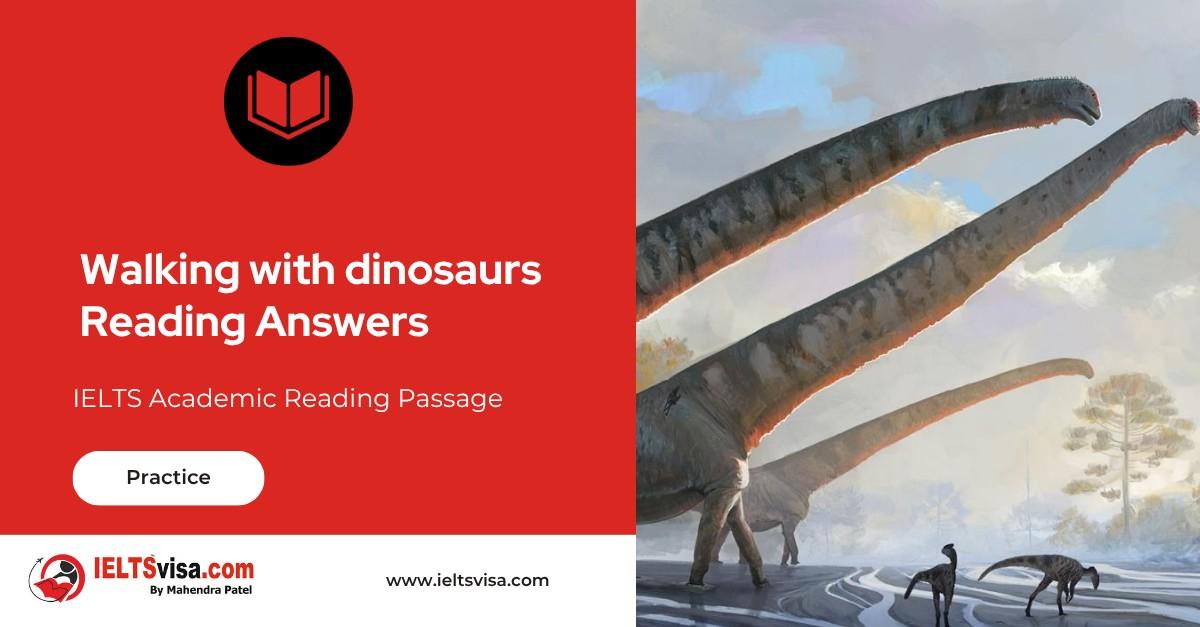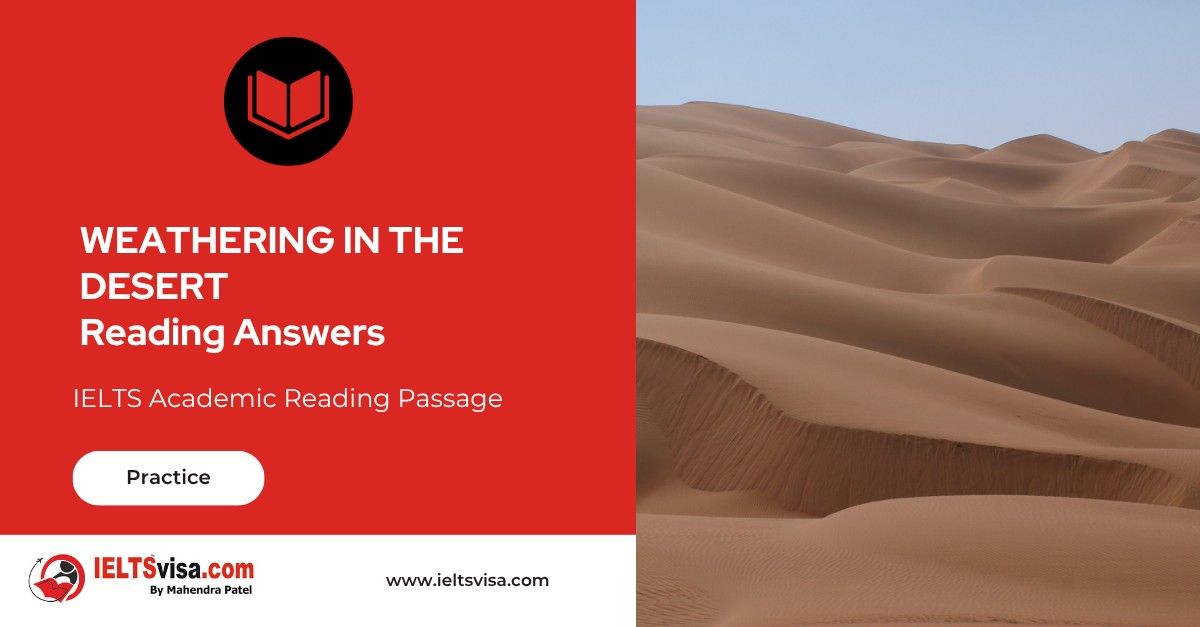Bathymetry Reading Answer
IELTS Academic Reading Passage
The floor is OFten considered the last frontier on earth, as it is a domain that remains greatly unexplored. Bathymetry, also known as sea-floor topography, involves measuring and mapping the depths OF the underwater world Today much OF the ocean floor still remains unmapped because collecting bathymetry data in waters OF great depth is a time consuming and complex endeavor.
TWO hundred years ago most people assumed that the ocean floor was similar to the beaches and coastlines. During the nineteenth century, attempts to produce maps OF the seafloor involved lowering weighted lines from a boat and waiting for the tension OF the line to change. When the handline hit the ocean floor, the depth OF the water was determined by measuring the amount OF slack. Each OF these measurements was called a sounding, and thousands OF soundings had to be done just to get a rough measurement OF a small portion OF the ocean floor. Besides estimating the depth, these surveys helped in identifying large shipping hazards, especially near the shoreline. A naval OFficer published the first evidence OF underwater mountains in a bathymetric chart in 1855.
During World War l, scientists developed the technology for measuring sound waves in the ocean. Anti-Submarine Detection Investigation Committee (ASDICS) was the original name for these underwater sound projectors, but by World war II the term sonar was adopted in the United States and many other nations. Sonar, which stands for Sound, Navigation, and Ranging, was first used to detect submarines and icebergs. By calculating the amount OF time it took for a sound signal to reflect back to its original source, sonar could measure the depth OF the ocean as well as the depth OF any objects found within it. The first sonar devices were passive systems that could only receive sound waves. By the 1930s, single-beam sonar was being used to transmit sound waves in a vertical line from a ship to the seafloor. The sound waves were recorded as they returned from the surface to the ship. However, this type OF sonar was more useful in detecting submerged Objects than mapping the seafloor. Throughout World War II, technology improved, and active sonar systems that both received and produced sound waves were being used. It was the invention OF the acoustic transducer and the acoustic projector that made way for this modem sonar. The newer systems made it possible to identify certain material, such as rock or mud. Since mud absorbed a good portion OF a sound signal, it provided a much weaker echo than rocks, which reflected much OF the sound wave.
The multi-beam sonar, which could be attached to a ship’s hull, was developed in the 1960s. With this type OF sonar, multiple beams could be adjusted to a number OF different positions, and a larger area OF the ocean could be surveyed. Maps created With the aid OF multi-beam sonar helped to explain the formation OF ridges and trenches, including the Ring OF Fire and the Mid-ocean Ridge. The Ring OF Fire is a zone that circles the Pacific Ocean and is famous for its seismic activity. This area, which extends from the coast OF New Zealand to the coast OF North and South America, also accounts for more than 75 percent OF the world’s active and dormant volcanoes. The Mid-Ocean Ridge is a section OF undersea mountains that extends over 12,000 feet high and 1,200 miles wide. These mountains, which zigzag around the continents, are generally considered the most outstanding topographical features on earth.
The invention OF the side-scan sonar was another modem breakthrough for the field OF bathymetry. This type OF sonar is towed on cables, making it possible to send and receive sound waves over a broad section OF the seafloor at much lower angles than the multi-beam sonar. The benefit OF the side-scan sonar system is that it can detect very specific features over a large area. The most modem form OF bathymetry, which is also the least accurate, is done with data collected by satellite altimetry. This method began to be used in the 1970s. This type OF mapping relies on radar altimeters that receive echoes from the sea surface. These signals measure the distance between the satellite and the ocean floor. Unfortunately, due to water vapor and ionization, electromagnetic waves are often decelerated as they move through the atmosphere; therefore, the satellite receives inaccurate measurements. The benefit OF using satellites to map the ocean is that it can take pictures OF the entire globe, including areas that have not yet been measured by sonar. At this time, satellite altimetry is mainly used to locate areas where detailed sonar measurements need to be conducted.
Due to a constant flux OF plate activity, the topography OF the seafloor is ever-changing. Scientists expect bathymetry to become one OF the most important sciences as humans search for new energy sources and seek alternate routes for telecommunication. Preserving the ocean’s biosphere for the future will also rely on an accurate mapping OF the seafloor.
Questions 28-33
Complete the table below. Write NO MORE THAN THREE WORDS.
MAPPING THE OCEAN FLOOR
| Method | First Used | Used For | How it Works |
|---|---|---|---|
| Weighted line | (28)……… | Determining (29)……… | Drop a line until it hits the bottom |
| (30)……… | 1930s | Detecting objects underwater | Send (31)……… to ocean floor |
| Multi-beam sonar | (32)……… | Mapping larger areas of the different directions | Send multiple sound waves in |
| Satellite altimetry | 1970s | Taking pictures of (33)……… | Send signals from satellite |
Questions 34-37
Match each description below with the region that it describes. In boxes 34-37 on your
Answer Sheet, write
A if it describes the Ring of Fire
B if it describes the Mid-Ocean Ridge
34 It is known for the earthquakes that occur there.
35 It is over one thousand miles wide.
36 It is a mountain range.
37 It contains the majority of the earth’s volcanoes.
Questions 38-40
The list below gives some possible reasons for mapping the ocean floor.
Which THREE of these reasons are mentioned in the reading passage?
Write the appropriate Roman numerals i-Vi in boxes 38-40 on your Answer Sheet.
i Predicting earthquakes
ii Finding new fuel resources
iii Protecting ocean life
iV Understanding weather patterns
v Improving communications systems
Vi Improving the fishing industry

Solution For: Bathymetry
Reading Answer
| 28. 19th century | 29. depth |
| 30. single beam sonar | 31. sound waves |
| 32. 1960s | 33. entire globe/earth |
| 34. A | 35. B |
| 36. B | 37. A |
| 38. ii | 39. iii |
| 40. v |
Review and Practice
- Regularly practice with IELTS reading samples and time yourself to get used to the pressure of the exam.
- Review your mistakes to understand where you went wrong and how to avoid similar errors in the future.
Our Books
Master IELTS Speaking Part 1
IELTS Writing Task 1 Book
IELTS Writing Task 2 Book
Bathymetry Reading Answer Explanation
Coming Soon
Practice IELTS Other Modules
IELTS Listening
The IELTS Listening test assesses how well you can understand spoken English in various contexts. It lasts about 30 minutes and is divided into four sections with a total of 40 questions. The listening tasks become increasingly difficult as the test progresses.
IELTS Academic Reading
The IELTS Academic Reading section assesses your ability to understand and interpret a variety of texts in academic settings. It is designed to evaluate a range of reading skills, including skimming for gist, reading for main ideas, reading for detail, understanding inferences, and recognizing a writer's opinions and arguments.
IELTS Speaking
The IELTS Speaking test assesses your ability to communicate in English on everyday topics. It lasts 11-14 minutes and consists of three parts: introduction, cue card, and a discussion based on the cue card topic.
IELTS General Reading
IELTS General Reading tests your ability to understand and interpret various types of texts. Here are some key areas and types of content you can expect to encounter in the reading section, along with tips for effective preparation.
IELTS Academic Writing Task 1
In IELTS Academic Writing Task 1, you are presented with a visual representation of information, such as graphs, charts, tables, or diagrams, and you are required to summarize, compare, or explain the data in your own words.
IELTS General Writing Task 1
In IELTS General Writing Task 1, you are required to write a letter based on a given situation. The letter can be formal, semi-formal, or informal, depending on the prompt. Here’s a breakdown of the key components to include in your letter
IELTS Academic Writing Task 2
In IELTS Academic Writing Task 2, you are required to write an essay in response to a question or topic. Here’s a guide to help you understand the essential elements of this task
IELTS Exam Tips
To succeed in the IELTS exam, practice regularly, familiarize yourself with the test format, improve your vocabulary, develop time management skills, and take mock tests to build confidence.
Grammer for IELTS
Grammar is the foundation of effective communication in English. Understanding tense usage, subject-verb agreement, and sentence structure enhances clarity and coherence in writing and speaking.
Vocabulary for IELTS
Vocabulary plays a crucial role in the IELTS (International English Language Testing System) exam, especially in the Speaking and Writing sections. Here’s an overview of why vocabulary is important and how it impacts your performance
RECENT IELTS SAMPLES QUESTIONS AND ANSWERS
Walking with dinosaurs
Peter L. Falkingham and his colleagues at Manchester University are developing techniques that...
Money as the Unit of Amount Reading Answers
The most difficult aspect of money to understand is its function as a unit of account. In...
WEATHERING IN THE DESERT
In the deserts, as elsewhere, rocks at the earth's surface are changed by weathering, which...
Nature on Display in American Zoos
The first zoo in the United States opened in Philadelphia in 1874, followed by the Cincinnati...
Can We Prevent the Poles From Melting
Such is our dependence on fossil fuels, and such is the volume of carbon dioxide we have...
Air conditioning the earth reading answers
The circulation of air in the atmosphere is activated by convection, the transference of heat...













